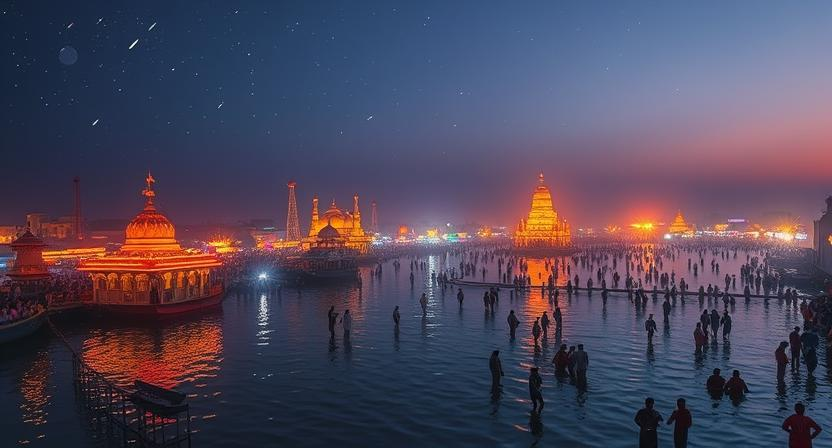Mahakumbh Mela 2025: A Celestial Confluence of Faith and Humanity
The Mahakumbh Mela, held from January 13th to February 26th, 2025, at the Triveni Sangam in Prayagraj, Uttar Pradesh, India, is an event of profound spiritual and cultural significance. With an estimated 400 to 450 million pilgrims expected by the end of the event on February 26th, it is considered the world’s largest gathering. As of January 31st, 2025, over 296.4 million devotees have already participated in the Mahakumbh at Prayagraj, taking a holy dip at the Sangam. While deeply rooted in Indian traditions, the Mahakumbh Mela transcends cultural and religious boundaries, offering a unique experience of humanity coming together in devotion, unity, and shared faith.
A Cosmic Alignment of Faith
The timing of the Mahakumbh Mela is linked to a rare celestial event when the Sun, Moon, and Jupiter align in specific positions in the sky. This event happens once every 12 years, but for the 2025 Mela, the alignment marks the culmination of a 144-year cycle, believed to amplify the spiritual benefits for participants. This rare cosmic connection draws pilgrims from around the world, adding a layer of awe to the already monumental gathering.
A Timeless Tradition
While rooted in Hindu mythology, the Mahakumbh Mela offers a universal message of spiritual exploration and human connection. One of the event’s most iconic rituals is the “Shahi Snan” (royal bath), where millions of pilgrims bathe in the Triveni Sangam—the confluence of the Ganges, Yamuna, and Saraswati rivers. This act of immersion is believed to cleanse sins and offer spiritual liberation, offering a profound sense of renewal for all who partake.
The Kumbh Mela Cycle
The Mahakumbh Mela is part of a grand cycle of Kumbh Melas that occur at four sacred locations in India—Haridwar, Prayagraj, Nashik, and Ujjain. Here’s a breakdown of the different types of Kumbh Melas:
| Type | Frequency | Locations | Significance |
| Kumbh Mela | Every 3 years | Haridwar, Prayagraj, Nashik, Ujjain | The most frequent gathering, held in rotation across the four locations. Millions of pilgrims seek spiritual renewal. |
| Ardh Kumbh Mela | Every 6 years | Haridwar, Prayagraj | Occurs between two Purna Kumbh Melas. A smaller but still significant event, attracting millions for sacred rituals. |
| Purna Kumbh Mela | Every 12 years | Haridwar, Prayagraj, Nashik, Ujjain | The major Kumbh, drawing millions for spiritual purification and the iconic royal bath. |
| Maha Kumbh Mela | Every 144 years | Only in Prayagraj | The rarest and grandest Kumbh, marking the completion of a 144-year cycle, drawing pilgrims for unparalleled spiritual benefits. |
A Celebration of Culture and Heritage
Beyond its spiritual significance, the Mahakumbh Mela is a vibrant celebration of Indian culture. The Akharas, monastic orders of ascetics, play a vital role. Known for their distinct traditions, rituals, and martial arts, they showcase the diverse spiritual and cultural heritage of India. The Akharas create a dynamic atmosphere of cultural exchange, offering a unique glimpse into Hindu philosophy and practices.
The Temporary City
The scale of the Mahakumbh Mela is unlike anything seen elsewhere in the world. As millions converge on Prayagraj, a temporary city springs up—complete with tents, markets, food stalls, and makeshift accommodations. The logistics of organizing such an event are staggering, yet it operates with remarkable efficiency. For visitors, it’s not only an opportunity for spiritual reflection, but also a chance to witness human cooperation on an immense scale.
A Global Gathering
While rooted in Indian culture, the Mahakumbh Mela is increasingly recognized as a global event. Pilgrims and tourists from around the world flock to Prayagraj, turning the Mela into a melting pot of cultures and traditions. UNESCO recognizes it as an Intangible Cultural Heritage of Humanity, underscoring its universal appeal. The Mela offers a unique opportunity for cultural exchange, bringing people together across borders and backgrounds.
Economic and Social Impact
The Mahakumbh Mela has a significant economic impact on the local region. The influx of millions of visitors drives demand for transportation, hospitality, and trade, creating revenue and providing employment opportunities. The Mela highlights the power of large gatherings to not only unite people but also drive economic activity and social change.
A Shared Human Experience
At its core, the Mahakumbh Mela is a celebration of the shared human experience. Whether participants come for spiritual reasons, cultural exploration, or simply out of curiosity, the event fosters a powerful sense of connection and belonging. In a world often divided by borders, ideologies, and cultures, the Mahakumbh Mela stands as a testament to the collective human spirit and our enduring desire for connection.
Interesting Fact
Did you know that the Mahakumbh Mela is so vast that its scale could be compared to the combined populations of multiple major cities? In fact, the crowd numbers far exceed those of the largest gatherings in sports and entertainment. It’s a sight to behold, not just for the sheer number of people, but for the shared sense of purpose and unity that binds them together.
The Mahakumbh Mela is not merely a religious gathering; it is a global phenomenon that brings people from all corners of the world together in a powerful celebration of faith, culture, and human connection. It’s an event that transcends time, space, and belief systems, offering something profound to everyone who witnesses or participates in it.



